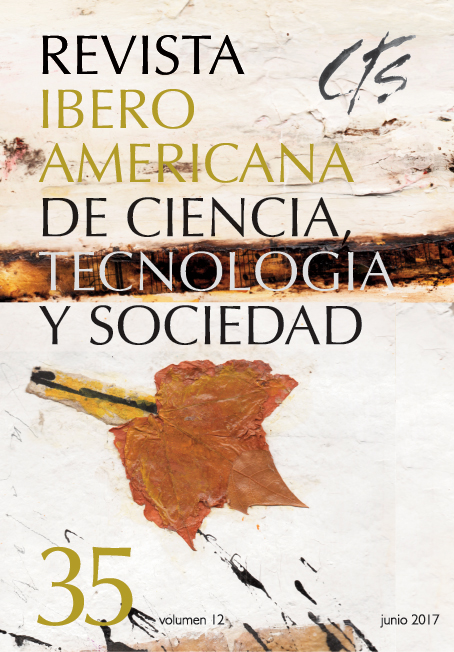Intellectual Property And Notions Of Life: Relationships, Conditions Of Possibility And Challenges
Keywords:
notions of life, intellectual property, genetically modified organismsAbstract
The powerful technologies of the 21st century set a special technological direction not only because of the productive and social transformations they generate, but also for being part of a project of dominant interests about nature and human existence. This paper focuses on the question raised around the ways and methods regarding the protection of knowledge and the link with the conceptualization of the living, connecting the development of science with different ways to provide a legal protection to inventions, throughout the different historical periods. Our general hypothesis is that there was a strong relation between the conceptualizations of life and the ways they were privatized from the 15th century onwards in the Western world. Therefore, this paper characterizes the links between intellectual property systems and the conceptualizations of the living during three different “moments”: the end of the Middle Ages and the beginning of the Renaissance, within the context of the Industrial Revolution, and the 20th and 21st centuries, considering said link for both, the patenting of living organisms in general and the case of genetically modified organisms (GMOs) in particular.Downloads
References
ALBERTS, B., JOHNSON, A., LEWIS, J., RAFF, M., ROBERTS, K. y WALTER, P. (2007): Molecular Biology of the Cell, Nueva York y Londres, Garland Publishing.
ÁLVAREZ, M. A. B. (2012): “Patentes fúngicas de Pasteur a nuestros días”, Revista Iberoamérica de Micología, vol. 29, n° 4, pp. 200-204.
CORIAT, B. y ORSI, F. (2007): “Propiedad Intelectual e Innovación“, Seminario Propiedad Intelectual e Innovación, CEIL-PIETTE y CONICET, Buenos Aires, 3 al 6 de diciembre 2007.
CORREA, C. (2006): Propiedad Intelectual y Salud Pública, Buenos Aires, La Ley.
DARTON, R. (1998): La gran matanza de gatos y otros episodios en la historia de la cultura francesa, Buenos Aires, Fondo de Cultura Económica de Argentina.
FUNDACIÓN HEINRICH BÖLL (2005): ¿Un mundo patentado? La privatización de la vida y el conocimiento?, El Salvador.
FOUCAULT, M. (1996): “¿Qué es la Ilustración?”, Genealogía del Poder, n° 30, Madrid, Ediciones de la Piqueta.
FOX-KELLER, E. (1995): Lenguaje y vida. Metáforas de la biología en el siglo XX, Buenos Aires, Editorial Manantial.
INSTITUTO INTERAMERICANO DE COOPERACIÓN PARA LA AGRICULTURA
(1991): Políticas de Propiedad Industrial de Inventos Biotecnológicos y Uso de Germoplasma en América Latina y el Caribe, San José, Costa Rica.
JABLONKA, E. y LAMB, M. (2010): “Transgenerational epigenetic inheritance”, en M. Pigliucci y G. B. Müller (eds): Evolution-the extended synthesis, Cambridge, The MIT Press, pp. 137–174.
JACOB, F. (1999): La lógica de lo viviente, Barcelona, Tusquets.
JONAS, H. (2000): El principio vida, Valladolid, Editorial Trotta.
KATZ, J. (1973): “Sistema Internacional de Patentes, Actividad Inventiva Local y Corporaciones Multinacionales: la Experiencia Argentina”, Comercio de Tecnología y Subdesarrollo Económico, Universidad Nacional Autónoma de México.
LARROYO, F. (2000): Instauratio Magna/Novum Organum/Nueva Atlántida, México DF, Editorial Porrúa.
MARCUSE, H. (1969): El hombre unidimensional, México DF, Editorial Joaquín Mortiz.
ROBLEDO, M. (2010): “Biotecnología y patentes”, Biotech Magazine. Disponible en: www.mkm.pi.com/Biotech/50020080778.
ROFFE, P. (2007): América Latina y la nueva arquitectura internacional de la propiedad intelectual: de los ADPIC-TRIPS a los nuevos tratados de libre comercio, Buenos Aires, La Ley.
THULLIER, P. (1985): “Cómo nació la biología molecular”, Biología molecular, Buenos Aires, Hyspamérica.
TIGAR, M. y LEVY, M. (1986): El Derecho y el Ascenso del Capitalismo, México DF, Siglo XXI Editores.
WATSON, J. y CRICK, F. (1953): “A Structure for Deoxyribose Nucleic Acid”, Nature, vol. 171, pp. 737-738.
WEST-EBERHARD, M. J. (2003): Developmental plasticity and evolution, Oxford, Oxford University Press.
WEST-EBERHARD, M. J. (2005): “Developmental plasticity and the origin of species differences”, Proceedings of the National Academy of Sciences of the United States of America, vol. 102, supl. 1, pp. 6543-6549.
ZAMUDIO, T. (1994): “Protección jurídica de las creaciones fitogenéticas”, Lecciones y Ensayos, n° 59, Buenos Aires, Editorial Abeledo-Perrot.
ZAMUDIO, T. (1998): Protección jurídica de las innovaciones, Buenos Aires, Editorial Ad. Hoc.
ZAMUDIO, T. (2005): “Patentes y materia viva”, Programa sobre Regulación Jurídica de las Biotecnologías, Buenos Aires, Universidad de Buenos Aires. Disponible en: www.biotech.bioética.org.
ZUKERFELD, M. (2010): Capitalismo y conocimiento: materialismo cognitivo, propiedad intelectual y capitalismo, tesis doctoral. Disponible en: www.capitalismoyconocimiento.wordpress.com.
ZUKERFELD, M. (2011): “Las regulaciones del acceso a los conocimientos en el período preindustrial. Introducción a una sociología jurídica de la propiedad industrial”. Revista Redes, vol. 17, n° 32, pp. 17-37.
Downloads
Published
How to Cite
Issue
Section
License
All CTS's issues and academic articles are under a CC-BY license.
Since 2007, CTS has provided open and free access to all its contents, including the complete archive of its quarterly edition and the different products presented in its electronic platform. This decision is based on the belief that offering free access to published materials helps to build a greater and better exchange of knowledge.
In turn, for the quarterly edition, CTS allows institutional and thematic repositories, as well as personal web pages, to self-archive articles in their post-print or editorial version, immediately after the publication of the final version of each issue and under the condition that a link to the original source will be incorporated into the self-archive.











